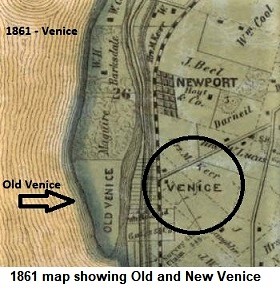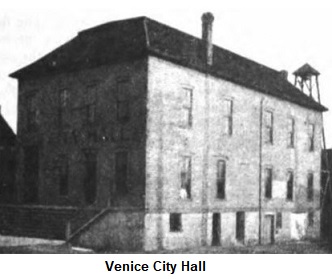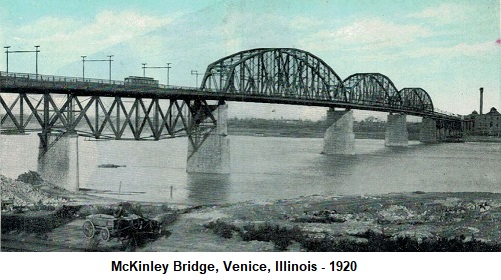Early History of Venice
The French were the first Europeans to settle near the future site of Venice, however very few of these colonists improved the land by building and cultivating. They were more interested in setting up trade between the Native Americans, fur trappers, and other settlers further east. During the French and Indian War (1754-1763), Great Britain gained control of the area, and the American Revolutionary War won American independence from the British.
The Founding of the Village of Venice
In about 1815, John Anthony, of Pennsylvania Dutch descent, built
the first house on the site of the old village of Venice. He
entertained travelers in a single-room house built of cottonwood
logs, and rented skiffs to those wanting to cross the Mississippi
River. His ferry also transported drovers and traders on their way
to St. Louis. In 1826, Matthew Kerr, a merchant of St. Louis (and
for whom Kerr’s Island was named) established a horse-powered ferry
at the present site of Venice. His annual license was fixed at
$20.00 by the county, and the name of his boat was “Brooklyn.” A
post office opened in 1838 under the name of Six Mile. The village
of Venice was platted in 1841 by Dr. Cornelius Campbell and Charles
F. Stamps. Campbell was largely interested in the ferry. The name
Venice was chosen because of the frequent flooding of the area. The
post office name was changed to Venice at that time.
Progress
In 1842, Lieutenant Robert E. Lee built a dike running from Kerr’s
Island south to the head of Bloody Island near St. Louis. This
necessitated a
 change
in the landing place of the “Brooklyn,” and the company operating
the ferry obtained $1,600 damages from the U. S. Government. This
money was used for the construction of a bridge connecting Kerr’s
Island with the mainland. The National Road terminated here, and
across Kerr’s Island was the principal street of Venice. The
“National Way,” as it was called, soon became the center of a large
trade. Two hotels catered to the needs of travelers, and two livery
stables supplied horses and vehicles. Three general stores and two
blacksmith shops were erected. One of the stores, kept by Peter
Smith, was the first brick building erected in Venice Township.
change
in the landing place of the “Brooklyn,” and the company operating
the ferry obtained $1,600 damages from the U. S. Government. This
money was used for the construction of a bridge connecting Kerr’s
Island with the mainland. The National Road terminated here, and
across Kerr’s Island was the principal street of Venice. The
“National Way,” as it was called, soon became the center of a large
trade. Two hotels catered to the needs of travelers, and two livery
stables supplied horses and vehicles. Three general stores and two
blacksmith shops were erected. One of the stores, kept by Peter
Smith, was the first brick building erected in Venice Township.
Destruction of Old Venice
The flood of 1844 swept everything in old Venice away except the
brick store building, a livery stable (also of brick), and a part of
one of the hotels. A German, in a fit of desperation, jumped from
the bridge as it was being carried off, and committed suicide. His
was the first smithery in the township, erected in 1837. As soon as
the waters receded, the work of repairing commenced. A finer bridge
soon spanned the slough, and business revived. Trade was represented
by Peter Smith, James Morris, and Charles Pearce – all engaged in
general merchandise.
In 1851, high waters again swept the old town of Venice away. Much
of the beautiful island was carried off, so that the former terminus
of “National Way” was far out in the Mississippi. The bridge was not
rebuilt. A solitary brick building remained on the once busy site of
Venice.
Venice Rebuilt and Incorporation
Recovery of Venice from the flooding was slow, but with the
establishment of the Venice Elevator, erected in 1871 by a stock
company (Messrs. R. P. Tansey and John J. Mitchell were the prime
investors of the enterprise), the industrial development of new
Venice went forward.
On June 24, 1873, an election was held to determine whether the town
should be incorporated. It resulted in seventy-nine votes for, and
one against. Venice was incorporated June 28, 1873, with Henry
Robinson, Joseph Froehly, Theodore Selb, Francis McCambridge,
William Roberts, and John Kaseberg elected as members of the first
board of trustees. Henry Robinson was chosen president, and Thomas
W. Kinder, secretary.
Industrial and Business Growth
The Venice Branch Union Stock Yards were established in 1874. They
had a capacity in 1882 for handling ten thousand head of hogs, and
five thousand head of cattle. W. A. Ramsay was the Manager, and J.
J. Fletcher, Superintendent.
In 1877, Bell Brothers of Indianapolis, Indiana, erected an
extensive sawmill on the banks of the Mississippi on the original
town site of Venice. In 1882, it was moved to Memphis.
The Venice Flour Mills were erected by Glenn Bros. in 1871, at a
cost of $22,000. They had five run of burrs, and were capable of
turning out four hundred barrels of flour daily (1882). Keohler
Bros. were the proprietors. On March 13, 1882, they were destroyed
by fire.
In 1882, the following businesses operated in Venice:
Dry Good Merchants – Henry Robinson & Co., Henry Rittmann
Druggists – C. S. Youree, Hermaun Wilfemeyer
Grocers – Fred Kohl, Joseph Froehly, Henry Robinson & Co.
Blacksmiths – F. Kaseberg, Joseph Froehly
Carpenters – Burrel Ogletree, B. V. Merritt, T. L. Conner, E. Mott
Stove and Tinware – J. H. Puckhaber
Shoemaker – F. Brewer
Hotel – the Union House, William H. Sippy, proprietor
Physicians – W. H. Grayson, C. S. Youree
Postmaster – James B. Pinckard
Venice Chartered as a Town
Venice was chartered on February 5, 1897. James Brammell served as
the first mayor from 1897-1899. Other early mayors include Dr. J. W.
Scott (1899-1911), Dr. John E. Lee Sr. (1911-1915, and 1917-1944),
and John Selb (1915-1917).
By 1912, other industrial interests located in Venice, such as the
Pittsburg Plate Glass Company, the Gibson Asphalt Company, the
Inter-State Cooperage Company, and others. The rail car barns of the
Alton, Granite & St. Louis, and the Illinois Traction Companies were
located there.
The McKinley Bridge
In August 1907 work began on the McKinley Bridge (named after
Congressman W. B. McKinley of Champaign, Illinois), which would take
traffic across the Mississippi from Venice to St. Louis (the
railroad track being in the center, and the auto lanes on the
outside lanes). In January 1910, the center span of the bridge
collapsed, and four men went down. They were saved after a
thirty-hour battle in the ice floes. They clung to a piledriver scow
after the crash, and had drifted ten miles south of the city when
the scow sank. They saved a ladder of the scow, and with this made
their way toward shore. Heavy fog prevented their being seen, but
their shouts for help were heard and their rescue followed.
On September 20, 1910, the first car of the Illinois Traction System
crossed the McKinley Bridge during a test run. It reached St. Louis
ten minutes later and proceeded to its St. Louis passenger station
at Twelfth Street and Lucas Avenue.
The bridge was formally opened and dedicated November 10, 1910.
Citizens were invited to the gala event. During the day visitors
were entertained by concerts and other amusements. At 2:30pm, a
parade was held and reviewed by the Governor H. S. Hadley of
Missouri and Governor W. S. Deneen of Illinois. Congressman McKinley
attended also. The Archbishop John J. Glennon of St. Louis held a
blessing and prayer service. After the dedication, a display of
fireworks was held.
In 1958, the city of Venice purchased the bridge from the Illinois
Terminal Railroad for nine million dollars in cash, and eleven
million dollars in bonds. Venice then raised the toll from 20 cents
to 25 cents per car. The railroad retained perpetual rights to use
the bridge. Railroad service was discontinued on the bridge in 1992.
The bridge was closed in 2001 due to unpaid taxes owed to St. Louis.
A settlement was reached in 2004 to turn control of the bridge to
Illinois, and forgive back taxes. In 2005 the highway approaches and
main spans were replaced. The bridge was reopened in 2007.
Early Schools
A grade school was erected a half a mile from the principal business
street of the village in 1868. It was a two-story brick building.
The Venice High School was established in 1917. It served the
community for nearly nine decades before closing in 2004. The
building has been razed. A charter school was established to
continue the education of Venice students.
Early Churches
The Methodist Episcopal Church was erected in 1870 at a cost of
$1,500. It had a seating capacity of 300.
The first service at the new St. Mark’s Catholic Church in Venice
was held April 16, 1882. Before this time, Catholics in Venice
attended church in East St. Louis and St. Louis. The cornerstone was
blessed October 25, 1881 by Rev. C. Koenig. Approximately 32
Catholic families attended.

